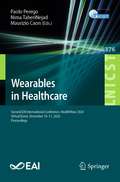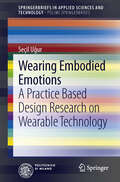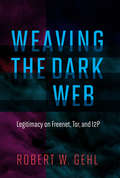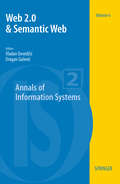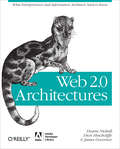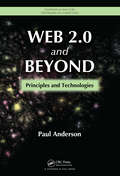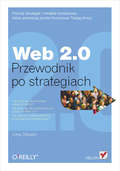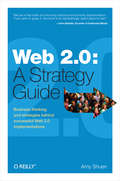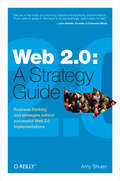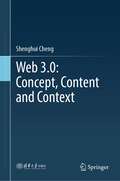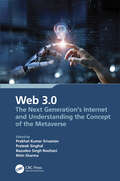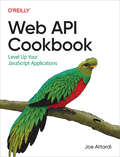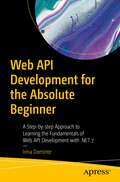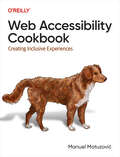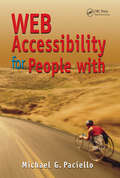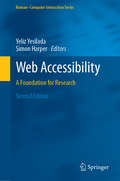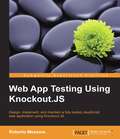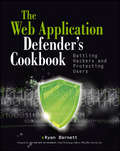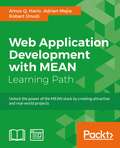- Table View
- List View
Wearables in Healthcare: Second EAI International Conference, HealthWear 2020, Virtual Event, December 10-11, 2020, Proceedings (Lecture Notes of the Institute for Computer Sciences, Social Informatics and Telecommunications Engineering #376)
by Paolo Perego Nima TaheriNejad Maurizio CaonThis book constitutes the refereed post-conference proceedings of the Second EAI International Conference on Wearables in Healthcare, HealthWear 2020. Due to COVID-19 pandemic the conference was held virtually. The 16 revised full papers were carefully reviewed and selected from 40 submissions. They focus on wearable devices and systems for healthcare and wellbeing. The papers are organized in topical sections as follows: PPG and algorithms focusing on photoplethysmography, PPG monitoring and cardiorespiratory measurement. The next section focus on IoT and smart sensors on the use of wearable devices and systems for Internet of Medical Things application. The third section is a new session introducing wearable applications. This track focuses on the intrinsic multidisciplinary of wearable devices, and includes works on methodology and design aspect of wearable research.
Wearing Embodied Emotions
by Seçil UğurToday, people are in an era of digitally mediated Human-to-Human Interaction, which cannot provide full sensorial contact and therefore, emotions cannot be communicated completely. The intimate cover of the human body, i.e. garment is the interface, where many personal traits are embodied. With the improvements in textile and electronics industry, this embodiment can be carried on a higher level, where the garments become dynamic interfaces and extensions of the human body. This book consists of a research on skin, clothes and technology as extensions of human body, emotions, technology-mediated emotions and a design practice that explores the communicative level of wearable technology through turning it into a living surface, which can convert intangible data to tangible in order to provide an emotional communication. This book aims to show how Human-Technology interaction is carried into an alternative context, where technology dissolves in use and starts serving for enhancing HHI.
Weaving the Dark Web: Legitimacy on Freenet, Tor, and I2P (The Information Society Series)
by Robert W. GehlAn exploration of the Dark Web—websites accessible only with special routing software—that examines the history of three anonymizing networks, Freenet, Tor, and I2P.The term “Dark Web” conjures up drug markets, unregulated gun sales, stolen credit cards. But, as Robert Gehl points out in Weaving the Dark Web, for each of these illegitimate uses, there are other, legitimate ones: the New York Times's anonymous whistleblowing system, for example, and the use of encryption by political dissidents. Defining the Dark Web straightforwardly as websites that can be accessed only with special routing software, and noting the frequent use of “legitimate” and its variations by users, journalists, and law enforcement to describe Dark Web practices (judging them “legit” or “sh!t”), Gehl uses the concept of legitimacy as a window into the Dark Web. He does so by examining the history of three Dark Web systems: Freenet, Tor, and I2P.Gehl presents three distinct meanings of legitimate: legitimate force, or the state's claim to a monopoly on violence; organizational propriety; and authenticity. He explores how Freenet, Tor, and I2P grappled with these different meanings, and then discusses each form of legitimacy in detail by examining Dark Web markets, search engines, and social networking sites. Finally, taking a broader view of the Dark Web, Gehl argues for the value of anonymous political speech in a time of ubiquitous surveillance. If we shut down the Dark Web, he argues, we lose a valuable channel for dissent.
Web 2.0
by Berthold H. Hass Gianfranco Walsh Thomas KilianNeue Technologien und Nutzungsarten machen das Internet interaktiver, neue Formen des Austauschs sind möglich geworden. So gestalten Nutzer Ideen und Produkte mit und werden zu wichtigen Wertschöpfungspartnern von Unternehmen. Dies zeigt, dass Web 2.0 mehr ist als nur ein neuer Internet-Hype. Der Band bietet eine praxisorientierte Einführung und einen systematischen Einblick in aktuelle Konzepte und Trends. Renommierte Autoren aus Wissenschaft und Praxis stellen neue Entwicklungen und praktische Anwendungen für Web 2.0 vor.
Web 2.0 & Semantic Web
by Dragan Gaševic Vladan DevedžicWeb 2.0 describes the trend in Web technology and design that aims to enhance creativity, information sharing, and, especially, collaboration among users. Semantic Web refers to the intelligent interaction among systems and applications on the Web by deploying ontologies, semantic annotation of Web content, and reasoning. Its ultimate goal is to make data understandable to computers, and thus open to far greater utility and manipulation. This special issue of AoIS presents cutting-edge research on both of these often opposed trends in computing and will support discussion on both the synergies and controversies inherent in the two technologies, while also considering what other technologies can contribute to both. Dramatic advances in service-oriented architectures, model-driven engineering, and Web mining technologies are but a few of the developments that might have a considerable impact on both Web 2.0 and Semantic Web, and they will all be covered in this volume.
Web 2.0 Architectures: What entrepreneurs and information architects need to know
by Dion Hinchcliffe Duane Nickull James GovernorWeb 2.0 is more pervasive than ever, with business analysts and technologists struggling to comprehend the opportunity it represents. So what exactly is Web 2.0 -- a marketing term or technical reality? This fascinating book finally puts substance behind the phenomenon by identifying the core patterns of Web 2.0, and by introducing an abstract model and reference architecture to help you take advantage of them.In Web 2.0 Architectures, authors Duane Nickull, Dion Hinchcliffe, and James Governor -- who have 40 years of combined experience with technical specifications and industry trends -- examine what makes successful Web 2.0 services such as Google AdSense, Flickr, BitTorrent, MySpace, Facebook, and Wikipedia work. The result is a base of knowledge that developers, business people, futurists, and entrepreneurs can understand and use as a source of ideas and inspiration. This book reveals:A Web 2.0 model: How the classic Client-Server model evolved into a more detailed Web 2.0 model.Web 2.0 reference architecture: A generic component view of basic Web 2.0 patterns that can be repurposed for other commercial ventures.Specific Web 2.0 patterns: How service oriented architecture (SOA), Software as a Service (SaaS), participation-collaboration, mashups, rich user experience, collaborative tagging systems (Folksonomy), and more can be used in your business.If you want to understand what makes Web 2.0 tick, and how it will enhance your business, Web 2.0 Architectures takes you right to the core.
Web 2.0 Solutions with Oracle WebCenter 11g
by Plinio Arbizu Ashok AggarwalThe book starts by explaining the context of the WEB 2.0 platform. It helps the reader to understand its main features and their application in organizations. It shows how the Oracle WebCenter technology can help you implement the Web 2.0 solutions. In each chapter, the theoretical concepts are tested with the help of practical applications. The apt recommendations and suggestions are other key points of the book. Filled with careful step-by-step instructions and plenty of screenshots, this tutorial shows you how to get the most out of the WebCenter Suite 11g. You will learn about integrating various services to enhance your Web 2.0 solutions using Oracle WebCenter. This book is for web developers who need to improve their websites or business applications using Web 2.0 features. This book is recommended for you, if you are a: Portal Developer who works with a traditional portal and wants to move onto new technologies Java Developer and want to add productivity features to your business applications Knowledge Managers and want to create collaborative environments and increase the productivity of your employees and organizational groups
Web 2.0 and Beyond: Principles and Technologies (Chapman & Hall/CRC Textbooks in Computing)
by Paul AndersonWeb 2.0 and Beyond: Principles and Technologies draws on the author's iceberg model of Web 2.0, which places the social Web at the tip of the iceberg underpinned by a framework of technologies and ideas. The author incorporates research from a range of areas, including business, economics, information science, law, media studies, psychology, social
Web 2.0. Przewodnik po strategiach
by Amy ShuenPoznaj strategie i modele biznesowe, które podnios? wyniki finansowe Twojej firmy! Jak zarabia?, dostarczaj?c us?ugi za darmo?Jak stworzy? dochodowy biznes, oparty na Web 2.0?Jak w??czy? strategie Web 2.0 w istniej?ce przedsi?wzi?cie?Je?li my?lisz, ?e Web 2.0 to wy??cznie technologia budowy interaktywnych portali internetowych, jeste? w b??dzie. Web 2.0 to rewolucja! To nowy sposób komunikacji przez internet, umo?liwiaj?cy u?ytkownikom wspólne tworzenie witryny i dzielenie si? wiedz?. Dzi?ki efektom sieci Web 2.0 staje si? ?ród?em okazji biznesowych. Jest miejscem, gdzie zaawansowana technologia ??czy si? z biznesem i gdzie -- udost?pniaj?c us?ugi za darmo -- mo?esz zarabia?. Web 2.0 przyjmuje bowiem fundamentalnie odmienny punkt widzenia na relacje mi?dzy biznesem, klientami i partnerami, a wi?c udost?pnia nam wszystkim nowe modele biznesowe. Ksi??ka "Web 2.0. Przewodnik po strategiach" zawiera omówienie wszystkich potrzebnych w biznesie technik i narz?dzi analitycznych, co sk?ada si? na ogólny obraz ekonomii opartej na Web 2.0. Z tego podr?cznika dowiesz si?, jak powstaj? efekty sieci, w jaki sposób prowokowa? i wykorzystywa? okazje biznesowe oraz zarabia? pieni?dze na dostarczonych przez u?ytkowników warto?ciach. Uwierzysz, ?e za pomoc? Web 2.0 mog? bogaci? si? i korporacje, i niewielkie przedsi?biorstwa. Poznasz sprawdzone narz?dzia i strategie oraz rewolucyjne modele biznesowe, stosowane przez takie firmy, jak Google czy Amazon. Pami?taj, ?e tym firmom przynios?y one wielki sukces i ogromne zyski.Wspólna warto?? u?ytkowników portalu Odkrywanie i wykorzystywanie grup internetowychPozytywne efekty sieciowe w Web 2.0Spieni??anie sieci spo?ecznychKoszty pozyskania klienta i szybko?? wzrostu zysku z reklamTworzenie warto?ci w sieciach spo?ecznychRozwijanie zdolno?ci adaptacyjnych przez Web 2.0Style innowacjiTworzenie biznesplanów Web 2.0 Przy??cz si? do rewolucji Web 2.0 i zarabiaj w internecie Wyró?nienie Magazynu Literackiego KSI??KIRedakcja Magazynu Literackiego KSI??KI przyzna?a ksi??ce "Web 2.0 - przewodnik po strategiach" w kwietniu 2009 roku Wyró?nienie za ksi??k? miesi?ca w kategorii Ekonomia http://helion.pl/img/rozne/wyd/wyd7_6.jpg" />
Web 2.0: Business Thinking and Strategies Behind Successful Web 2.0 Implementations
by Amy ShuenWeb 2.0 makes headlines, but how does it make money? This concise guide explains what's different about Web 2.0 and how those differences can improve your company's bottom line. Whether you're an executive plotting the next move, a small business owner looking to expand, or an entrepreneur planning a startup, Web 2.0: A Strategy Guide illustrates through real-life examples how businesses, large and small, are creating new opportunities on today's Web.This book is about strategy. Rather than focus on the technology, the examples concentrate on its effect. You will learn that creating a Web 2.0 business, or integrating Web 2.0 strategies with your existing business, means creating places online where people like to come together to share what they think, see, and do. When people come together over the Web, the result can be much more than the sum of the parts. The customers themselves help build the site, as old-fashioned "word of mouth" becomes hypergrowth.Web 2.0: A Strategy Guide demonstrates the power of this new paradigm by examining how: Flickr, a classic user-driven business, created value for itself by helping users create their own valueGoogle made money with a model based on free search, and changed the rules for doing business on the Web-opening opportunities you can take advantage ofSocial network effects can support a business-ever wonder how FaceBook grew so quickly?Businesses like Amazon tap into the Web as a source of indirect revenue, using creative new approaches to monetize the investments they've made in the WebWritten by Amy Shuen, an authority on Silicon Valley business models and innovation economics, Web 2.0: A Strategy Guide explains how to transform your business by looking at specific practices for integrating Web 2.0 with what you do. If you're executing business strategy and want to know how the Web is changing business, this book is for you.
Web 2.0: Business thinking and strategies behind successful Web 2.0 implementations.
by Amy ShuenWeb 2.0 makes headlines, but how does it make money? This concise guide explains what's different about Web 2.0 and how those differences can improve your company's bottom line. Whether you're an executive plotting the next move, a small business owner looking to expand, or an entrepreneur planning a startup, Web 2.0: A Strategy Guide illustrates through real-life examples how businesses, large and small, are creating new opportunities on today's Web. This book is about strategy. Rather than focus on the technology, the examples concentrate on its effect. You will learn that creating a Web 2.0 business, or integrating Web 2.0 strategies with your existing business, means creating places online where people like to come together to share what they think, see, and do. When people come together over the Web, the result can be much more than the sum of the parts. The customers themselves help build the site, as old-fashioned "word of mouth" becomes hypergrowth.Web 2.0: A Strategy Guide demonstrates the power of this new paradigm by examining how: Flickr, a classic user-driven business, created value for itself by helping users create their own value Google made money with a model based on free search, and changed the rules for doing business on the Web-opening opportunities you can take advantage ofSocial network effects can support a business-ever wonder how FaceBook grew so quickly? Businesses like Amazon tap into the Web as a source of indirect revenue, using creative new approaches to monetize the investments they've made in the Web Written by Amy Shuen, an authority on Silicon Valley business models and innovation economics, Web 2.0: A Strategy Guide explains how to transform your business by looking at specific practices for integrating Web 2.0 with what you do. If you're executing business strategy and want to know how the Web is changing business, this book is for you.
Web 3.0: Concept, Content and Context
by Shenghui ChengAs technology continues to advance, the Internet is evolving into what is often referred to as Web 3.0. This book aims to achieve three main objectives, first, it introduces Web 3.0 systematically and comprehensively, providing readers with a foundational understanding of its concepts and characteristics. Second, it analyzes the inevitability and development necessity of Web 3.0, as well as its potential future possibilities and transformative effects. Finally, it explores Web 3.0 through comparative analysis, discussing its relationship with the metaverse as well as how individuals and organizations can seize the opportunities presented by Web 3.0. Various topics related to Web 3.0, including its infrastructure, development facilities, scenario applications, technology stacks, and industry applications such as decentralized applications (DApps) and Software-as-a-Service (SaaS) platforms are presented in the book. It delves into the ecosystem of Web 3.0, discussing decentralized autonomous organizations (DAOs), open finance (DeFi), cryptocurrencies, token economy, digital identity, creator economy, attention economy, and cyber-physical and human systems. Additionally, it addresses governance issues, security challenges, development challenges, and legal and regulatory aspects associated with Web 3.0. Overall, Web 3.0: Concept, Content and Context provides readers with a comprehensive understanding of Web 3.0, its potential implications, and the opportunities for new industry models and business opportunities in the evolving Internet era.
Web 3.0: The Next Generation's Internet and Understanding the Concept of the Metaverse
by Prateek Singhal Prabhat Kumar Srivastav Basudeo Singh Roohani Nitin SharmaThe book underscores AI's transformative impact on reshaping physical, digital, and biological boundaries, converging with technologies like robotics, IoT, 3D printing, genetic engineering, and quantum computing—termed Web 3.0 Industrial Revolution. This global revolution integrates advanced production techniques beyond connected machines, extending into gene sequencing, nanotechnology, renewable energies, and quantum computing. The book's main goals include providing a collaborative platform for academia and industry researchers to share contributions and shape the future through knowledge exchange. Recognizing recent progress driven by increased computing power, it highlights the positive impact of digital technology—AI, IoT, AR/VR, Additive Manufacturing, CPS, cloud computing, and robotics—on industrial efficiency and quality. Revolutionary AI Fusion: AI revolutionizes by blending physical, digital, and biological boundaries through cutting-edge technologies like robotics, IoT, 3D printing, genetic engineering, and quantum computing. Global Manufacturing Cooperation: AI creates a collaborative landscape where virtual and physical systems flexibly cooperate on a global scale. AI's Diverse Impact: Beyond smart machines, AI drives breakthroughs in gene sequencing, nanotechnology, renewable energies, and quantum computing, distinguishing it from prior industrial revolutions. Progress and Digital Interface: Recent progress, powered by computing advancements, boosts industrial efficiency. The digital technology interface (AI, IoT, AR/VR, 3D Printing, CPS, CC, Robotics) significantly impacts industrial performance. In conclusion, AI spearheads a transformative revolution, redefining the boundaries of the physical, digital, and biological realms. The fusion of AI with Web 3.0 Industrial Revolution, integrating advanced production techniques and global manufacturing cooperation, surpassing past industrial shifts. The book aims to be a collaborative platform for academia and industry researchers, fostering knowledge exchange to shape the future. In AI-driven manufacturing within Web 3.0, a paradigm shift envisions maximum output with minimal resource use. Coupled with 'Digital Reality,' it transforms business practices, consumer behaviour, and employment dynamics, redistributing wealth toward innovation and technology.
Web API Cookbook: Level Up Your JavaScript Applications
by Joe AttardiJavaScript gives web developers great power to create rich interactive browser experiences, and much of that power is provided by the browser itself. Modern web APIs enable web-based applications to come to life like never before, supporting actions that once required browser plug-ins. Some are still in an experimental stage, but many are ready for use today.With this hands-on cookbook, author Joe Attardi helps you explore the powerful APIs available in modern browsers and guides you through the specific tasks that they unlock. Because these features are web standards, there is comprehensive documentation available from trusted resources such as MDN Web Docs. The knowledge you'll gain is transferable across different companies and projects.Learn the breadth of functionality available in modern browser APIsExplore future APIs that are still in an experimental stageDiscover newer elements, such as dialog that replaces the need for a third-party libraryBuild more powerful and interactive web applications using native APIsUnderstand the permissions model used by the browser to unlock functionality such as geolocation and push notifications
Web API Development for the Absolute Beginner: A Step-by-step Approach to Learning the Fundamentals of Web API Development with .NET 7
by Irina DominteIf you are a developer who wants to learn the basic skills of web and application programming interfaces (APIs) with .NET, this book is your complete introduction. The book takes a learn-by-experience approach. You will hit the ground running with a sample project that has everything you need to be wired up.As you follow along, you will learn simple and intuitive conventions that will free you from some of the more tedious decisions and work, in order to allow you to focus on the business requirements required by your team. Certain components of the framework should always appear in certain folders in the solution to speed up development while others need a name that follows particular conventions. You will learn the building blocks of Web API and how to leverage them to have a well-rounded API. Understanding these small but important tricks will make development faster, easier, and more pleasant, and will prevent time-consuming errors.Part I introduces you to the basics of Web. Part II gets you started creating an API that you will use and build upon throughout the book until you have a complete project. All companion code is available via GitHub. Part III covers more advanced concepts, including how to override out-of-the-box conventions to customize an API to meet your specific business needs. By the end of the book you will have a fully functional API, and you will be better prepared for an interview for a .NET backend developer job.What You Will Learn Build a start-to-finish Web APIKnow the main concepts of the WebApply best practices in API development to your own projectsKnow the fundamentals of Web API developmentKnow the fundamentals of a RESTful APILeverage Web API constructs to implement a clean and extensible APIGet hands-on experience to unit test a Web APIGain the skills required to apply for a junior or entry-level .NET Web developer job Who This Book Is ForDevelopers who want to learn API development with .NET. It is helpful to have some basic C# programming knowledge because it is used in API development in .NET, but it is not mandatory. Readers should be familiar with a programming language to be able to understand code and examples. Experience with web development is not necessary.
Web Accessibility
by Yeliz Yesilada Simon HarperCovering key areas of evaluation and methodology, client-side applications, specialist and novel technologies, along with initial appraisals of disabilities, this important book provides comprehensive coverage of web accessibility. Written by leading experts in the field, it provides an overview of existing research and also looks at future developments, providing a much deeper insight than can be obtained through existing research libraries, aggregations, or search engines.
Web Accessibility Cookbook: Creating Inclusive Experiences
by Manuel MatuzovicFrontend developers have to consider many things: browser compatibility, usability, performance, scalability, SEO, and other best practices. But the most fundamental aspect of creating websites is one that often falls short: accessibility. Accessibility is the cornerstone of any website, and if a website is inaccessible, users won't be able to interact with it, obtain information, sign up for services, or buy products.The Web Accessibility Cookbook provides you with dozens of recipes to help you avoid these failures. You'll learn how to build common components, such as main navigation, filters, and dialogs, in an accessible manner. Each recipe not only explains how to build things but also why. Author Manuel Matuzovic provides the knowledge you need to create your own accessible components and address your users' varying needs, abilities, and preferences.With this practical guide, you will:Learn how to build websites that feature inclusive frontendsDiscover the common obstacles website users face every dayUnderstand how your decisions impact usersLearn how to build accessible frontends step-by-stepWrite high-quality markup and CSSEvaluate the accessibility of frontend components
Web Accessibility for People with Disabilities
by Mike PacielloKey Benefits Comply with all legal mandates and standards Master HTML enhancements for accessibility Employ the best accessibility tools Make your Web site accessible to everyone! This definitive resource provides Internet and Web administrators and devel
Web Accessibility: A Foundation for Research (Human–Computer Interaction Series)
by Yeliz Yesilada Simon HarperCovering key areas of evaluation and methodology, client-side applications, specialist and novel technologies, along with initial appraisals of disabilities, this important book provides comprehensive coverage of web accessibility. Written by leading experts in the field, it provides an overview of existing research and also looks at future developments, providing a much deeper insight than can be obtained through existing research libraries, aggregations, or search engines.
Web Accessibility: Web Standards and Regulatory Compliance
by Jim Thatcher Cynthia Waddell Mark Urban Andrew Kirkpatrick Richard Rutter Christian Heilmann Shawn Lawton Henry Patrick H. Lauke Bruce Lawson Bob Regan Michael R. BurksThe power of the Web lies in the fact that anyone and everyone can access it. However, this should also extend to users with disabilities--accessibility is about making websites accessible to those with aural, visual, or physical disabilities, or rather, constructing websites that don't exclude these people from accessing the content or services being provided. This isn't difficult to do, and doesn't require anything more than your normal toolset, be it HTML, CSS, JavaScript, Flash, or whatever else. All you need to do is use these tools in the right way, and bear in mind the guidelines that exist to help you keep your web sites accessible, and the laws that enforce web accessibility around the world. This book gives you all you need to know about web accessibility, whether you are a web designer or developer who wants their sites to be accessible, or a business manager who wants to learn what impact the web accessibility laws have on their businesses' web sites.
Web Analytics 2.0
by Avinash KaushikAdeptly address today's business challenges with this powerful new book from web analytics thought leader Avinash Kaushik. Web Analytics 2.0 presents a new framework that will permanently change how you think about analytics. It provides specific recommendations for creating an actionable strategy, applying analytical techniques correctly, solving challenges such as measuring social media and multichannel campaigns, achieving optimal success by leveraging experimentation, and employing tactics for truly listening to your customers. The book will help your organization become more data driven while you become a super analysis ninja!Note: CD-ROM/DVD and other supplementary materials are not included as part of eBook file.
Web App Development and Real-Time Web Analytics with Python: Develop and Integrate Machine Learning Algorithms into Web Apps
by Tshepo Chris NokeriLearn to develop and deploy dashboards as web apps using the Python programming language, and how to integrate algorithms into web apps. Author Tshepo Chris Nokeri begins by introducing you to the basics of constructing and styling static and interactive charts and tables before exploring the basics of HTML, CSS, and Bootstrap, including an approach to building web pages with HTML. From there, he’ll show you the key Python web frameworks and techniques for building web apps with them. You’ll then see how to style web apps and incorporate themes, including interactive charts and tables to build dashboards, followed by a walkthrough of creating URL routes and securing web apps. You’ll then progress to more advanced topics, like building machine learning algorithms and integrating them into a web app. The book concludes with a demonstration of how to deploy web apps in prevalent cloud platforms. Web App Development and Real-Time Web Analytics with Python is ideal for intermediate data scientists, machine learning engineers, and web developers, who have little or no knowledge about building web apps that implement bootstrap technologies. After completing this book, you will have the knowledge necessary to create added value for your organization, as you will understand how to link front-end and back-end development, including machine learning. What You Will Learn Create interactive graphs and render static graphs into interactive ones Understand the essentials of HTML, CSS, and Bootstrap Gain insight into the key Python web frameworks, and how to develop web applications using them Develop machine learning algorithms and integrate them into web apps Secure web apps and deploy them to cloud platforms Who This Book Is For Intermediate data scientists, machine learning engineers, and web developers.
Web App Testing Using Knockout.JS
by Roberto MessoraIf you are a JavaScript developer, beginner, or an expert who wants to improve quality standards in terms of solutions design and functional verification, this book is for you. Basic understanding of web development, HTML, and JavaScript is required.
Web Application Defender's Cookbook
by Jeremiah Grossman Ryan C. BarnettDefending your web applications against hackers and attackersThe top-selling book Web Application Hacker's Handbook showed how attackers and hackers identify and attack vulnerable live web applications. This new Web Application Defender's Cookbook is the perfect counterpoint to that book: it shows you how to defend. Authored by a highly credentialed defensive security expert, this new book details defensive security methods and can be used as courseware for training network security personnel, web server administrators, and security consultants.Each "recipe" shows you a way to detect and defend against malicious behavior and provides working code examples for the ModSecurity web application firewall module. Topics include identifying vulnerabilities, setting hacker traps, defending different access points, enforcing application flows, and much more.Provides practical tactics for detecting web attacks and malicious behavior and defending against themWritten by a preeminent authority on web application firewall technology and web application defense tactics Offers a series of "recipes" that include working code examples for the open-source ModSecurity web application firewall moduleFind the tools, techniques, and expert information you need to detect and respond to web application attacks with Web Application Defender's Cookbook: Battling Hackers and Protecting Users.
Web Application Development with MEAN
by Amos Q. Haviv Adrian Mejia Robert OnodiUnlock the power of the MEAN stack by creating attractive and real-world projects About This Book * Learn about the different components that comprise a MEAN application to construct a fully functional MEAN application using the best third-party modules * A step-by-step guide to developing the MEAN stack components from scratch to achieve maximum flexibility when building an e-commerce application * Build optimum end-to-end web applications using the MEAN stack Who This Book Is For This learning path is for web developers who are experienced in developing applications using JavaScript. This course is for developers who are interested in learning how to build modern and multiple web applications using MongoDB, Express, AngularJS, and Node.js. What You Will Learn * Build modern, end-to-end web applications by employing the full-stack web development solution of MEAN * Connect your Express application to MongoDB and use a Mongoose model and build a complex application from start to finish in MongoDB * Employ AngularJS to build responsive UI components * Implement multiple authentication strategies such as OAuth, JsonWebToken, and Sessions * Enhance your website's usability with social logins such as Facebook, Twitter, and Google * Secure your app by creating SSL certificates and run payment platforms in a live environment * Implement a chat application from scratch using Socket.IO * Create distributed applications and use the power of server-side rendering in your applications * Extend a project with a real-time bidding system using WebSockets In Detail The MEAN stack is a collection of the most popular modern tools for web development. This course will help you to build a custom e-commerce app along with several other applications. You will progress to creating several applications with MEAN. The first module in this course will provide you with the skills you need to successfully create, maintain, and test a MEAN application. Starting with MEAN core frameworks, this course will explain each framework key concepts of MongoDB, Express, AngularJS, and Node.js. We will walk through the different tools and frameworks that will help expedite your daily development cycles. After this, the next module will show you how to create your own e-commerce application using the MEAN stack. It takes you step by step through the parallel process of learning and building to develop a production-ready, high-quality e-commerce site from scratch. It also shows you how to manage user authentication and authorization, check multiple payment platforms, add a product search and navigation feature, deploy a production-ready e-commerce site, and finally add your own high-quality feature to the site. The final step in this course will enable you to build a better foundation for your AngularJS apps. You'll learn how to build complex real-life applications with the MEAN stack and a few more advanced projects. You will become familiar with WebSockets, build real-time web applications, create auto-destructing entities, and see how to work with monetary data in Mongo. You will also find out how to a build real-time e-commerce application. This learning path combines some of the best that Packt has to offer in one complete, curated package. It includes content from the following Packt products: * MEAN Web Development by Amos Haviv * Building an E-Commerce Application with MEAN by Adrian Mejia * MEAN Blueprints by Robert Onodi Style and approach This course will begin with the introduction to MEAN, gradually progressing with building applications in each framework. Each transition is well explained, and each chapter begins with the required background knowledge.
